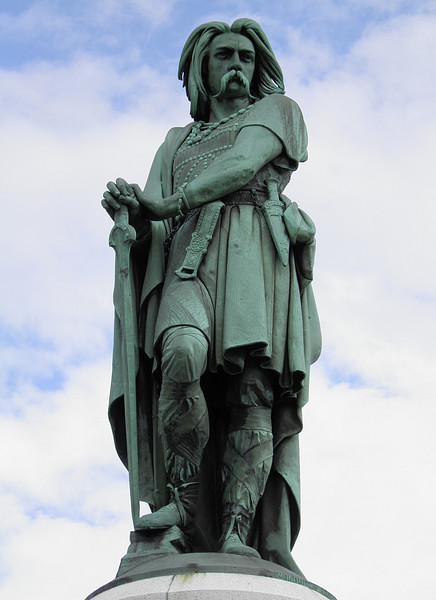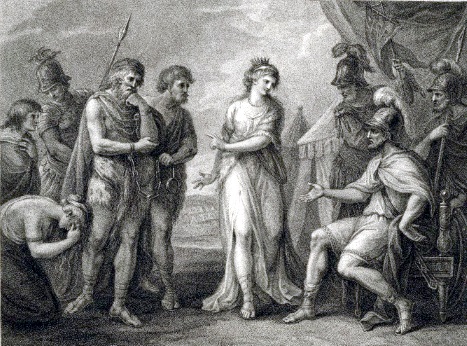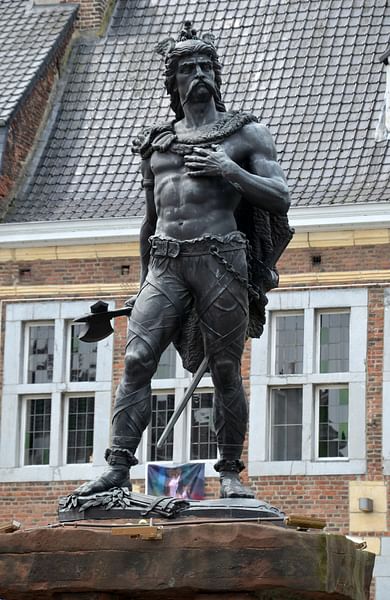Many historians conjure a somewhat mystical picture of the Celtics, a people who occupied what is part of modern-day Western Europe. The first documentation of the Celtics appeared in Roman writings during the seventh or eighth century BC, where the Romans described them as Galli or barbarians. However, the Greek historian Diodorus Siculus mentioned them in his writings in the first century BC, describing them as prone to being overly arrogant and indulgent in wine, often leading to stupor. Furthermore, Siculus stated that the men grew their beards long and wore brightly colored garments. Although hospitable, they were easy to provoke and fearless warriors who wouldn’t back down from any fight.
The Celtics didn’t leave any written accounts, and historians surmise that their social life revolved around small tribes. However, Roman accounts state that they were among the fiercest warriors they encountered and were sometimes difficult to pacify and subdue.
Boudicca

Boudica, also known as Boudicea, Boadicea, Boudicca, and Buddug, was the warrior queen of the Iceni tribe. Historians place her birth around 30 AD in Britannia. She is considered a British folk hero for leading an uprising against the invading Roman Empire forces in 60 or 61 AD.
She was a member of the royalty owing to her marriage to Prasutagus, a Roman ally. She gave birth to two daughters, whose names have been lost in history. Upon her husband’s demise, he willed the kingdom to his daughters and the Roman emperor. However, they didnt uphold his will. Instead, they annexed his territory and properties. Furthermore, they flogged Queen Boudica and raped her daughters.
She led the Iceni, Trinovantes, and other tribes against governor Gaius Suetonius Paulinus. Unfortunately, she either died of illness or killed herself to avoid capture after she failed during the uprising.
Vercingetorix

Historians place his birth in 82 BCE. He was a Gallic chieftain who rallied the Gauls to repel the invading Roman forces led by Julius Caesar in 52 BCE. The son of the Averni chieftain, Celtillus, he was given the appellation Vercingetorix, which means “Victor of a Hundred Battles.” It is the only name he is known for as his birth name has been lost to history and Celtic culture.
Accounts say he was a handsome, tall, charismatic leader who was quite the eloquent speaker. He was also an exacting and demanding leader whose tactics helped to defeat the Romans. He previously served under Julius Caesar as one of the leaders of the cavalry units, and his knowledge of Roman tendencies helped him guide the tribes to thwart the invaders.
He advocated using scorched earth tactics and guerilla warfare to hamper the advance of Caesar’s forces during their military campaign.
Cartimandua (Cartismandua)

Queen Cartimandua reigned from AD 43 until 69 and was the leader of the Brigantes tribe in what is now northern England. Historians are still debating whether she came to power as a matter of birth and if she established her reign before or after the start of the Roman conquest.
She was thought to be one of the 11 Celtic kings who accepted Roman rule peacefully and established a large group of tribes who became loyal to the Romans. Tacitus described her and her husband Venutius as loyal allies to Rome. She handed over the rebel leader Caratacus to the Romans in chains, perhaps as a show of her loyalty.
She divorced Venutius and replaced him with his armor-bearer, Vellocatus. Spited by his wife, Venutius staged a war against them in 57 AD, and although Cartimandua retained her throne with Roman help, Venutius subsequently emerged victorious in 69 AD.
Caractacus

Historians place Caratacus’s birth somewhere around 10 AD, probably in the Catuvellauni territory of Britain, to Cunobelinus, the tribal chieftain. He proved a brilliant leader as he was associated with the subsequent expansion of the Catuvellauni land as they fought against neighboring tribes.
His success in expanding their kingdom led to the invasion of the Romans, who showed support for their defeated enemies. He succeeded in thwarting the Romans for almost a decade. He was adept at guerilla warfare and set-piece battles against formidable foes. However, he failed against Publius Ostorius Scapula in 50 AD somewhere in the Ordovician territory, resulting in the capture of his wife and daughter and his brothers’ surrender.
Queen Cartimandua captured him as he sought refuge and turned him over to the Romans. He was to be executed as a political prisoner, but he convinced Emperor Claudius to spare his life in a rousing oratory.
Venutius

Venutius was the king of the Brigantes tribe in the 1st century AD. However, some historians and accounts say that he was a member of the Carvetii tribe, one of the tribes that comprised the Brigantes confederation.
He was the husband of Queen Cartimandua and became even more prominent after the capture of the rebel leader Caratacus whom the queen handed over to the Romans in chains. However, Queen Cartimandua tired of him and married his armor-bearer Vellocatus.
He became the face of the Celtic resistance against the Romans as he sought to overthrow his former wife from the position of power. The Romans rushed to defend her, and they managed to thwart Venutius’ rebellion. However, Venutius bided his time and started another revolt in 69 AD. This time, however, Cartimandua only received auxiliaries from her roman protectors as they were at odds during the year of the four emperors.
Brennus

The chieftain of the Senones tribe, Brennus, was an accomplished military leader who defeated the Romans in the Battle of the Allia in 390 BC. He led an army of Cisalpine Gauls, a branch of the Senones tribe who drove out the Umbrians and settled in Ager-Gallicus, in an attack on Rome. They captured most of the city for several months, making it the first time in 800 years that a foreign army occupied the fabled city before the city fell to the Visigoths.
Brennus and his men also invaded Etruria in 391 BC, leading to the siege of Clusium. The Clusines looked to Rome for assistance, sending Quintus Fabius Ambustus and his brothers to come to terms with Brennus. Historians are still at odds as they argue that the Clusium story may be fiction, and Brennus was working in tandem with Dionysius of Syracuse, who sought to control Messana.
Boduognatus

Boduognatus was one of the few leaders of the Belgic Nervii people during that era who came close to defeating the mighty Julius Caesar on the field of battle. His name is said to be the translation of “he who was born of the battle crow,” which tells people what kind of person he was.
He was the overall commander of the Belgic forces during the Battle of the Sabis in 57 AD in what is now modern Saulzior in Northern France. Against eight of Caesar’s legions, numbering approximately 35,000 – 40,000 fighting men, including various skirmishers and cavalry units, Boduognatus led about 40,000 Celts into battle. Their guerilla warfare tactics surprised the Roman baggage trains, and if not for the swift decision-making of Julius Caesar, everything would have been lost to the Celtic attack. Instead, the highly-trained Romans turned the attackers back at a significant loss to both sides.
Ambiorix

Ambiorix ruled over the Eburones tribe with Catuvolcus. They settled in the north-eastern region of Gaul in what is now modern-day Belgium. Julius Caesar’s advance to conquer parts of Gaul and Belgica in 57 AD caused supply problems, and they encamped near the Eburones’ territory. The Romans forced the tribes to give part of their harvest to the army, which caused widespread resentment among the tribesmen.
Although Caesar freed Ambiorix from paying tribute to them, he was still swayed to join Catuvolcus in an uprising against the Romans led by Lucious Aurinculeius Cotta and Quintus Titurious Sabinus in 54 AD. Ambiorix persuaded them to flee, whereupon the Eburones massacred the Roman forces a short distance from their camp. They also surrounded Quintus Tullius Cicero’s camp, but Caesar defeated them in a fierce battle. Ambiorix and his forces managed to escape through the Rhine after several years of fighting the Romans.
Cassivellaunus

Cassivellaunus was a member of the Catevellauni tribe. He was a brave military leader who opposed the incursion of Julius Caesar during the Gallic Wars in 55 and 54 BC. He was at the forefront of the British defense against the second incursion in 54 BC. However, Caesar marched onward with a mightier force consisting of 628 ships, 2000 cavalrymen, and five legions of Roman soldiers from Kent to Middlesex and eventually crossed the Thames. Unfortunately, the defeated Britons betrayed his location, forcing him to surrender.
Before his surrender, Cassivellaunus proved to be a thorn on Caesar’s side as he harried their troops, relying on guerilla tactics, his knowledge of local geography, and his speedy chariots. It took the surrender and subsequent betrayal of five tribes – the Segontiaci, Cenimagni, Ancalites, Bibroci, and Cassi – of his stronghold’s location that he was besieged and forced to lay down his arms.
Viridomarus

Viridomarus or Britomartus was a Gaul military leader who led their army against the Romans during the Battle of Clastidium. The battle happened in 222 BC between the Romans and the Insubres tribe from northern Italy. Consul Marcus Claudius Marcellus led the Romans.
The Insubres were dealt a defeat in 223 BC and sent ambassadors to the Roman senate to beg for mercy. However, consuls Marcellus and Gnaeus Cornelius Scipio Calvus disagreed. This led the Insubres to hire 30,000 Gaesatae mercenaries for their last stand.
The Romans laid siege at Acerrae, and the Insubres responded by holding Clastidium under siege. Marcellus sent his cavalry, and although they turned back from the Gallic lines, turned it into a dedication.
Viridomarus challenged the consul to single combat, and Marcellus indulged him. Marcellus defeated him, and the Romans pursued the Gauls, who suffered heavy losses as most of them drowned in the Po.